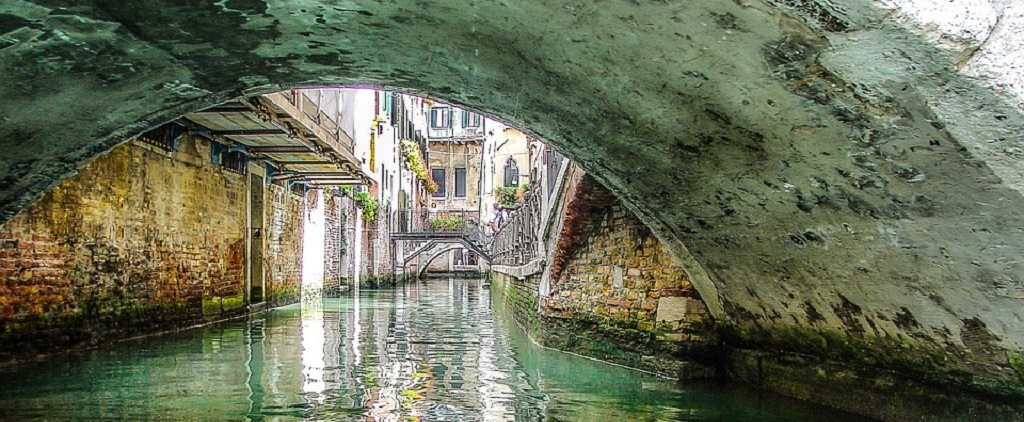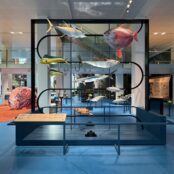[dropcap style=”font-size:100px; color:#992211;”]D[/dropcap]amien Hirst’s blue backlit photographs glow through the windows of Punta della Dogana and Palazzo Grassi as you travel up and down the Grand Canal at night.
The first glimpse of his works from the outside are three grand sculptures guarding the entrances of each building, introducing an exhibition that will encourage viewers to suspend disbelief.
Hundreds of banners throughout the city advertise Hirst’s Treasures from the Wreck of the Unbelievable, an immense exhibition across two museums which have never been simultaneously dedicated to a single artist. The show follows a fantastical narrative, that of the wreckage of a ship named the Unbelievable containing Cif Amotan II’s life-long acquisitions. The pieces in the exhibition are portrayed as treasures from his collection, retrieved 2000 years later from the South African coast. A 60 page booklet guides you through the presented objects, each containing aspects of history and mythology from ancient civilisations across the globe.
The display not only echoes the fate of Venice as a sinking treasure, but also resonates through the omnipresence of water in Punta della Dogana and its history as a custom warehouse for goods arriving by sea. Palazzo Grassi, which used to be a rich merchant’s palace, presented archaeological exhibitions devoted to Phoenicians, Celts, Greeks, and Etruscans amongst other cultures present in Damien Hirsts’s work. Everything about the exhibition’s atmosphere makes it immersive; you must cross the river to get from one museum to the next.
The exhibition begins at Punta della Dogana, where historical information about the expedition is accompanied by documentary-style film and photography of divers recovering the coral-covered treasures from the bottom of the ocean. The first room contains two of the most impressive pieces of the exhibition; The Diver and The Warrior and the Bear. The latter, which represents a giant bear ridden by a young girl, relates to the ancient Greek maturation ritual of arkteia in which girls imitated bears whilst dancing and performing sacrifices.
The theme of empowered female figures resurges throughout the exhibition, particularly in Punta della Dogana. Lion Women of Asit Mayor shows a woman controlling a lion on a leash, recalling Near East sculptures in the entrances of Hittite temples dedicated to the goddess Ishtar. These often featured women taming fantastical beasts acting as guardians of the temple.
Hermaphrodite, a sculpture of the dual-sexed god which gives name to what is today viewed as an unfortunate medical condition, is presented as an image of balance. Some ancient thinkers attributed the possession of complementary forces as a reflection of purity. In Plato’s Symposium, for example, Aristophanes describes the combination of male and female within one body as a source of strength and vigour. One of the most interesting aspects of Hirst’s collection is that although it essentially displays aspects of different cultures throughout history, it encourages the viewer to link past ideologies to current issues such as gender identity and sexuality, raising questions about our values and promoting different modes of thought.
Aten, represents the Egyptian solar goddess yet bears a striking resemblance to Rihanna. This isn’t the only appearance by figures of popular culture; Kate Moss and Pharell Williams appear disguised as deities whilst other figures such as Mickey Mouse, Goofy, or Optimus Prime appear directly. The Collector with a Friend, featuring Damien Hirst himself holding Mickey Mouse by the hand, is the first comical appearance in an otherwise serious and historically heavy exhibition. These figures bring in the contemporary aspects of humour in art and reject the classically seriousness attached to classical art and culture.
Metamorphosis is an example of an extraction of a myth. Hirst explores the metamorphic story of Arachne, a Lydian woman who challenged Athena to a weaving contest and crafted a tapestry portraying the god’s transgressions. As a punishment, Athena turned Arachne into a spider cursed to weave for all eternity. Metamorphosis, however, presents a female morphed with a fly. Through the story (which is explained in the booklet accompanying the exhibition) the work raises the issue of antagonism between creativity and authority very much present today, whilst reinventing an undocumented myth and creating a historical artefact to go with it.
The two bronze Hydra and Kali sculptures are visually the strongest sculptures in Punta della Dogana. Standing side by side, one bronze is painted black whilst the other is covered in coral, the five metre tall statues portray a six-armed woman fighting the seven-headed beast Hydra, Hercule’s mighty opponent. Yet, as you enter Palazzo Grassi, Hydra and Kali become mere miniatures. Demon with Bowl (Exhibition Enlargement), is without doubt the most breathtaking sculpture in the exhibition. Over 18 meters high, it barely fits inside the building and has everybody lying on the floor trying to get a picture of it in its entirety. The ankles of this greater than life demon stand at eye-level. As you go up the floors, the open balconies allow you to see it from different heights and angles.
Although it is hard to criticise the exhibition after witnessing such a monumental sculpture, breathtaking in size and quality of detail, Damien Hirst’s character as not only an artist but also a businessman comes across in the not-so-subtle repetition of sculptures throughout Palazzo Grassi. The exact sculpture of Medusa’s severed head, for example, is presented in gold, malachite, glass, and bronze. Although the saleability of the work is essential to his success, and the only way an exhibition of such magnitude could go ahead, it does make the viewing experience somewhat repetitive. Wherever you start, although I would recommend starting at Punta della Dogana, many of the sculptures in the second building will be replicas in different materials. The shelves of artefacts, although important for the context and immersive quality of the exhibition, are also something you’ll most likely walk past without looking at carefully, after having been to the third room filled with necklaces and rings.
Even though the citiy’s famous Biennale books your agenda for at least two long days of art viewing, Treasures from the Wreck of the Unbelievable may be the most outstanding collection work in Venice this year. The sheer amount of pieces, the variety of materials ranging form jade and rock crystal to carrara marble and bronze, and the beauty of detail and craft in each of the sculptures will definitely guide you through the history of ancient civilisations in a somewhat surreal way.
Sidebar image: Pixabay/Kirkandmimi
Born in Barcelona and based in London, Anna writes about art, techno and psychogeography. She is also a lover of film photography and is slowly building an Olympus camera collection.





















